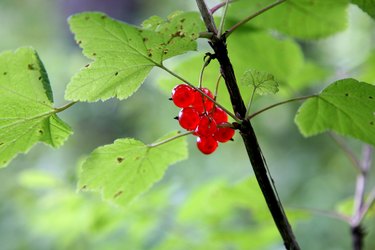
Wild currant shrubs are all found in the genus Ribes, but they are not all one species. In fact, there are some 50 species of Ribes in the United States. No two species are exactly alike, and there are great differences among some of them. Then, there are their cousins, gooseberry shrubs, which are found in the same genus.
While it is difficult to become familiar enough with the Ribes family to differentiate all of the different species, a few general rules apply to identifying a shrub as a wild currant.
Video of the Day
Video of the Day
Wild Currant Stems and Leaves
Wild currants are relatively short shrubs that rarely grow taller than 6 feet. What they lack in height they make up for in breadth. While each individual wild current shrub is slender, these are clumping plants, and one stem is rarely seen alone.
If you are a fan of maple leaves, you'll love currant leaves as well. The two look similar, with scalloped edges and three, four, or five distinct lobes. They are spaced alternately, meaning they are not directly across from each other on a branch. The size of the leaves varies from small to palm size.
Leaf veins are another characteristic of currants. Look for veins that fan out from the leaf base like fingers on a hand. Currant leaves usually produce a strong smell if crushed. Some species smell like lemons, some smell spicy, and others smell quite a bit like skunk.
Wild Current Flowers and Fruit
All currant shrubs flower in the spring. The flowers, however, are hardly uniform. Some currant bush flowers, like those of the wild black currant (Ribes americanum), are yellowish and bell-shaped, growing in dangling clusters. Other species produce currant flowers in white or red that may look more like little plates. Many are fragrant, and all give way to clusters of green berries over the course of the growing season. Gardeners sometimes cultivate these plants for their blossoms and fruits.
These berries are the currants, and most ripen into black or red berries. Red currants are are a dull red and tend to ripen all at once. Black currants are a darker purplish-brown. They ripen from the top of the bush down.
Gooseberry vs. Wild Currant
Gooseberry species in the United States closely resemble wild currants and share the genus Ribes. They have the same maplelike leaves with three to five deep lobes. Gooseberry shrubs also produce bell-shaped flowers that develop into berries.
If you are wondering how to tell currants from gooseberries, there is a clear and definitive distinction. Gooseberry shrub stems are spiny, while currant shrubs are smooth and have no thorns.